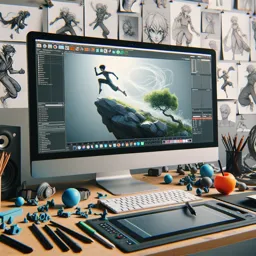Introduction
Character animation is one of the most captivating aspects of 3D animation. It brings digital characters to life, making them move, talk, and express emotion. Whether you’re working in film, video games, or advertising, mastering character animation is essential for crafting compelling and believable stories. In this article, we’ll explore the key techniques and best practices that will help you perfect your 3D character animation skills.
Understanding the Principles of Animation
Before diving into tools and workflows, it’s vital to understand the foundational principles that guide all great animation. Concepts like squash and stretch, anticipation, arcs, and follow-through make movement feel natural and expressive. These classic principles, established by traditional animators, remain relevant and powerful in modern 3D workflows.
Rigging: The Foundation of Character Animation
Rigging is the process of building a skeleton or control system for your 3D model. It allows animators to move characters efficiently, enabling everything from walking and running to nuanced facial expressions. A strong rig should offer flexibility and intuitive controls—especially around joints like the spine, shoulders, hands, and face.
Blocking Out Your Animation
Start your animation by establishing the key poses—this is known as blocking. Focus on storytelling poses that define the beginning, middle, and end of a movement. Use stepped or constant interpolation to avoid automatic in-betweens. At this stage, clarity is more important than detail. Make sure your poses communicate intent and emotion with strong silhouettes.
Spline and Polish: Refining Motion
Once blocking is complete, switch to spline interpolation to refine motion. This is where your animation becomes fluid and expressive. Focus on:
- Arcs: Smooth motion paths that mimic natural movement.
- Timing: Ensuring fast and slow actions reflect physical reality and emotional beats.
- Ease in and out: Gradual acceleration and deceleration for believable motion.
- Secondary motion: Add overlapping elements like hair, tails, or clothing for realism.
Polishing is also where you fine-tune gestures and facial expressions to bring emotional depth to your characters.
Tips for Creating Believable Characters
- Study real-life references: Watch how people and animals move to understand mechanics and emotion.
- Embrace imperfections: Small asymmetries and natural gestures make characters feel human.
- Use exaggeration strategically: Highlight key actions or emotions with bold movements.
- Keep the audience focused: Ensure every movement supports the character’s intention and personality.
Conclusion
3D character animation is a powerful blend of art and technique. By mastering the core principles, creating effective rigs, and polishing animations with care and observation, you can build characters that truly connect with audiences. Stay curious, practice consistently, and let your creativity lead the way as you grow in your animation journey.

















